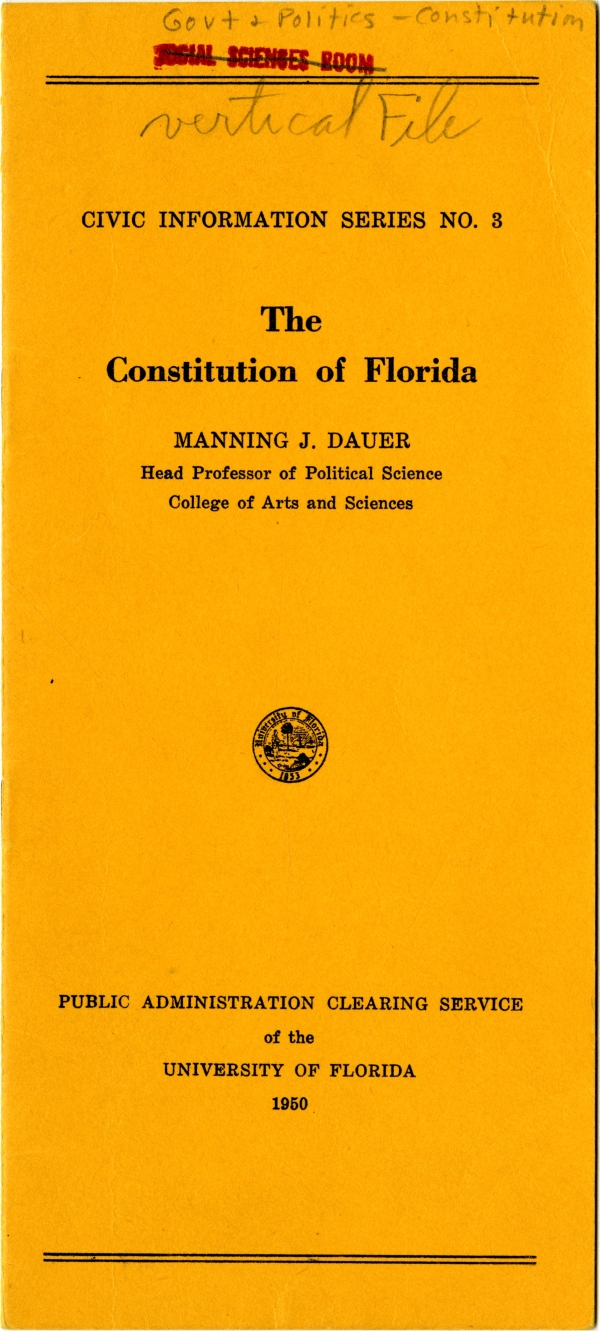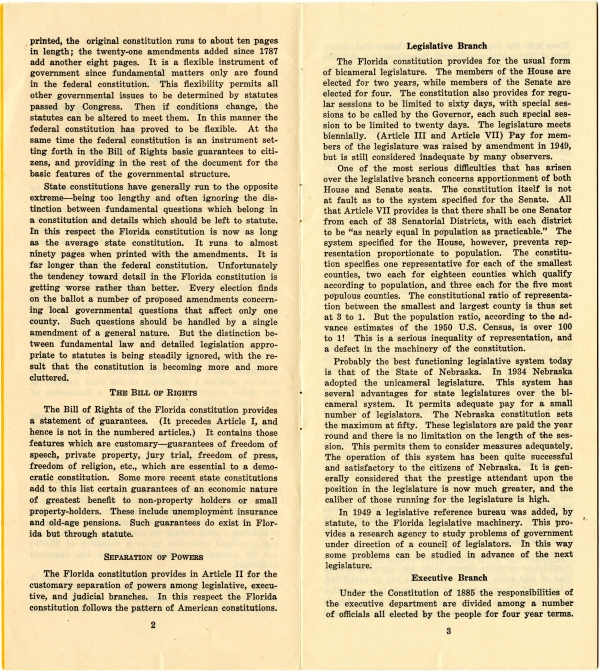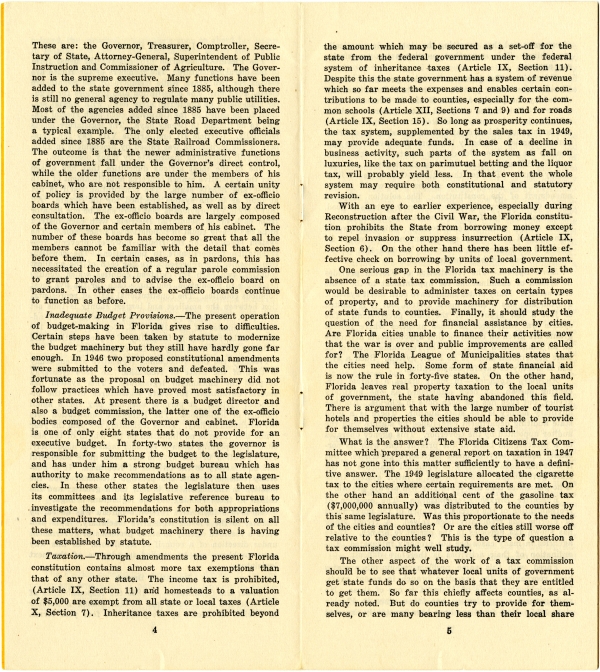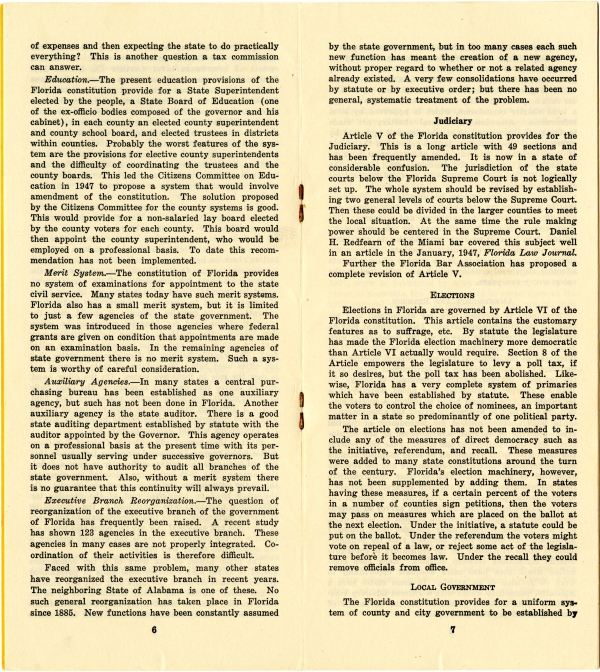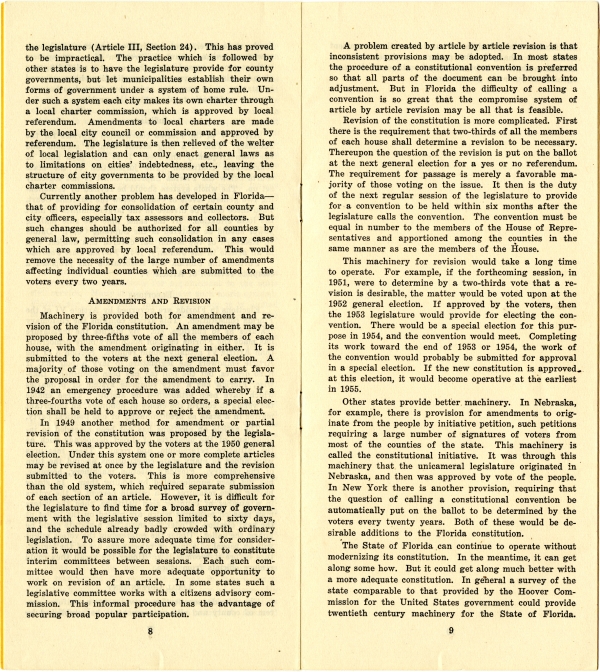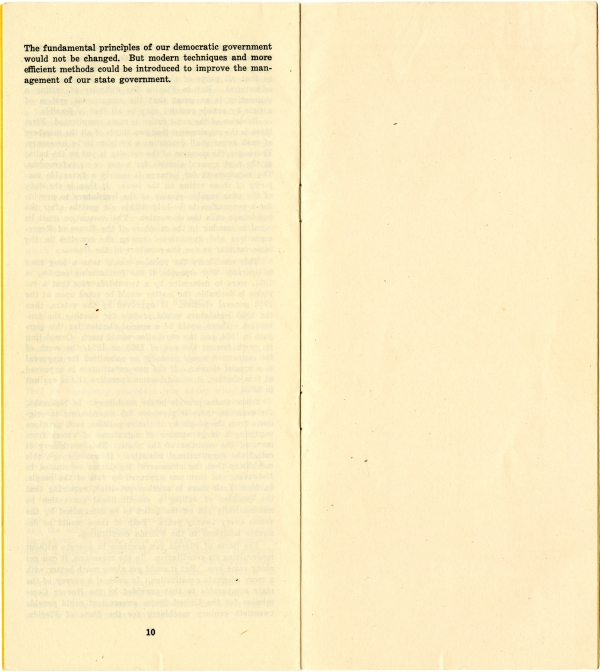Transcript
CIVIC INFORMATION SERIES NO. 3
The Constitution of Florida
MANNING J. DAUER
Head Professor of Political Science
College of Arts and Sciences
PUBLIC ADMINISTRATION CLEARING SERVICE of the UNIVERSITY OF FLORIDA
1950
The CIVIC INFORMATION SERIES is designed to stimulate discussion of those issues which closely affect the citizens of the State of Florida.
The views and opinions expressed are those of the author and are not to be construed as official views of the University.
The Constitution of Florida
MANNING J. DAUER
Head Professor of Policial Science
College of Arts and Sciences
The present Constitution of Florida was written by the Constitutional Convention of 1885. It is Florida's fifth constitution and has lasted longer than all the others together. It establishes the basic organization of the state government. In 188 the functions of the Florida government were so few that only $563,836.22 was spent on them. Today the basic organization of the government is the same although many functions have been added and other functions have been expanded until in the fiscal year ending June 30, 1949 the State spent over $167,700,000.00. In addition the State transmitted over $64,000,000 to counties principally for expenditures on schools, roads, and bonds. But the basic organization of county government is also unchanged from 1885; and the provisions for city government are inadequate for present conditions.
The question which arises is: How well does this constitution meet current requirements? To answer this question requires a description of the chief features of the state's constitution, together with a description of how certain other states are organized.
The Constitution of Florida has been changed many times since 1885. A total of 129 amendments have been submitted by the legislature to be voted on by the people in the sixty-five years since the constitution was written. Eighty-two of these amendments have been approved by the voters, and five additional will be voted on this fall in the regular November elections. It is in the manner that many important features of the constitution have been added. Most of these pertain to details, however, rather than to the fundamental structure of the constitution. Some are quite important, such as the amendment prohibiting a state income tax and the amendment granting homestead exemption up to a valuation of $5,000; but the general governmental structure has remained unchanged.
One important test of a good constitution is that it should contain only fundamental law. Our United States Constitution is the best example of a constitution that limits itself to a fundamental law. It is short. When
1
printed, the original constitution runs to about ten pages in length; the twenty-one amendment added since 1787 add another right page. It is a flexible instrument of government since fundamental matters only are found in the federal constitution. This flexibility permits all other governmental issues to be determined by statutes passed by Congress. Then if conditions change, the statutes can be altered to meet them. In this manner the federal constitution has proved to be flexible. At the same time the federal constitution is an instrument setting forth in the Bill of Rights basic guarantees to citizens, and providing in the rest of the document for the basic features of the governmental structure.
State constitutions have generally run to the opposite extreme-being too lengthy and often ignoring the distinction between fundamental questions which belong in a constitution and details which should be left to statute. In this respect the Florida constitution is now as long as the average state constitution. It runs to almost ninety pages when printed with the amendments. It is far longer than the federal constitution. Unfortunately the tendency toward detail in the Florida constitution is getting worse rather than better. Every election finds on the ballot a number of proposed amendments concerning local government questions that affect only one county. Such questions should be handled by a single amendment of a general nature. But the distinction between fundamental law and detailed legislation appropriate to statutes is being steadily ignored, with the result that the constitution is becoming more and more cluttered.
THE BILL OF RIGHTS
The Bill of Rights of the Florida Constitution provides a statement of guarantees. (It precedes Article I, and hence is not in the numbered articles.) It contains those features which are customary-guarantees of freedom of speech, private property, jury trial, freedom of press, freedom of religion, etc., which are essential to a democratic constitution. Some more recent state constitutions add to this list certain guarantees of an economic nature of greatest benefit to non-property holders or small property-holders. These include unemployment insurance and old-age pensions. Such guarantees do exist in Florida but through statute.
SEPARATION OF POWERS
The Florida Constitution provides in Article II for the customary separation of powers among legislative, executive, and judicial branches. In this respect the Florida constitution follows the pattern of American constitutions.
2
Legislative Branch
The Florida Constitution provides for the usual form of bicameral legislature. The members of the House are elected for two years, while members of the Senate are elected for four. The constitution also provides for regular sessions to be limited to sixty days, with special sessions to be called by the Governor, each such special session to be limited to twenty days. The legislature meets biennially. (Article III and Article VII) Pay for members of the legislature was raised by amendment in 1949, but is still considered inadequate by many observers.
One of the most serious difficulties that has arisen over the legislative branch concerns apportionment of both House and Senate seats. The constitution itself is not at fault as to the system specified for the Senate. All that Article VII provides is that there shall be on Senator from each of 38 Senatorial Districts, with each district to be "as nearly equal in population as practicable." The system specified for the House, however, prevents representation proportionate to population. The constitution specifies one representative for each of the smallest counties, two each for eighteen counties which quality according to population, and three each for the five most populous counties. The constitutional ratio of representation between the smallest and largest county is thus set at 3 to 1. Byt the population ratio, according to the advance estimates of the 1950 U.S. Census, is over 100 to 1! This is a serious inequality of representation, and a defect in the machinery of the constitution.
Probably the best functioning legislative system today is that of the State of Nebraska. In 1934 Nebraska adopted the unicameral legislature. This system has several advantages for state legislatures over the bicameral system. It permits adequate pay for a small number of legislators. The Nebraska constitution sets the maximum at fifty. These legislators are paid the year round and there is no limitation on the length of the session. This permits them to consider measures adequately. The operation of this system has been quite successful and satisfactory to the citizens of Nebraska. It is generally considered that the prestige attendant upon the position in the legislature is now much greater, and the caliber of those running for the legislature is high.
In 1949 a legislative reference bureau was added, by statute, to the Florida legislative machinery. This provides a research agency to study problems of government under direction of council of legislators. In this way some problems can be studied in advance of the next legislature.
Executive Branch
Under the Constitution of 1885 the responsibilities of the executive department are divided among a number of officials elected by the people for four-year terms.
3
These are: the Governor, Treasurer, Comptroller, Secretary of State, Attorney-General, Superintendent of Public Instruction and Commissioner of Agriculture. The Governor is the supreme executive. Many functions have been added to the state government since 1885, although there is still no general agency to regulate many public utilities. most of the agencies added since 1885 have been placed under the Governor, the State Road Department being a typical example. The only elected executive officials added since 1885 are the State Railroad Commissioners. The outcome is that the newer administrative functions of government fall under the Governor's direct control, while the older functions are under the members of his cabinet, who are not responsible to him. A certain unity of policy is provided by the large number of ex-officio boards which have been established, as well as by direct consultation. The ex-officio boards are largely composed of the Governor and certain members of his cabinet. The number of these boards has become so great that all the members cannot be familiar with the detail that comes before them. In certain cases, as in pardons, this has necessitated the creation of a regular parole commission to grant paroles and to advise the ex-officio board on pardons. In other cases the ex-officio boards continue to function as before.
Inadequate Budget provisions.-The present operation of budget-making in Florida give rise to difficulties. Certain steps have been taken by statue to modernize the budget machinery but they still have hardly gone for enough. In 1946 two proposed constitutional amendments were submitted to the voters and defeated. This was fortunate as the proposal on budget machinery did not follow practices which have proved most satisfactory in other states. At present there is a budget director and also budget commission, the latter one of the ex-officio bodies composed of the Governor and cabinet. Florida is one of only eight states that do not provide for an executive budget. In forty-two states the governor is responsible for submitting the budget to the legislature, and has under him a strong budget bureau which has authority to make recommendations as to all state agencies. In these other states the legislature then uses its committees and its legislative reference bureau to investigate the recommendations for both appropriations and expenditures. Florida's constitution is silent on all these matters, what budget machinery there is having been established by statute.
Taxation.-Through amendments the present Florida constitution contains almost more tax exemptions than that of any other state. The income tax is prohibited, (Article IX, Section 11) and homesteads to a valuation of $5,000 are exempt from all state or local taxes (Article X, Section 7). Inheritance taxes are prohibited beyond
4
the amount which may be secured as a set-off for the state from the federal government under the federal system of inheritance taxes (Article IX, Section 11). Despite this the state government has a system of revenue which so far meets the expenses and enables certain contributions to be made to counties, especially for the commons schools (Article XII, Sections 7 and 9) and for roads (Article IX, Section 15). So long as prosperity continues, the tax system, supplemented by the sales tax in 1949, may provide adequate funds. In case of a decline in business activity, such parts of the system as fall on luxuries, like the tax on parimutuel betting and the liquor tax, will probably yield less. in that event the whole system may require both constitutional and statutory revision.
With an eye to earlier experience, especially during Reconstruction after the Civil War, the Florida Constitution prohibits the State from borrowing money except to repel invasion or suppress insurrection (Article IX, Section 6). On the other hand there has been little effective check on borrowing by units of local government.
One serious gap in the Florida tax machinery is the absence of a state tax commission. Such a commission would be desireable to administer taxes on certain type of property, and to provide machinery for distribution of state funds to counties. Finally, it should study the question of the need for financial assistance by cities. Are Florida cities unable to finance their activities now that the war is over and public improvements are called for? The Florida League of Municipalities states that the cities need help. Some form of state financial aid is now the rule in forty-five states. On the other hand, Florida leaves real property taxation to the local units of government, the state having abandoned this field. There is argument that with the large number of tourist hotels and properties the cities should be able to provide for themselves without extensive state aid.
What is the answer? The Florida Citizens Tax Committee which prepared a general report on taxation in 1947 has not gone into this matter sufficiently to have a definitive answer. The 1949 legislature allocated the cigarette tax to the cities where certain requirements are met. On the other hand an additional cent of the gasoline tax ($7,000,000 annually) was distributed to the counties by the same legislature. Was this proportionate to the needs of the cities and counties? Or are the cities still worse off relative to the counties? This is the type of question a tax commission might well study.
The other aspect of the work of a tax commission should be to see that whatever local units of government get state funds do so on the basis that they are entitled to get them. So far this chiefly affects counties, as already noted. But do counties try to provide for themselves, or are any bearing less than their local share
5
of expenses and then expecting the state to do practically everything? This is another question a tax commission can answer.
Education.-The present education provisions of the Florida constitution provide for a State Superintendent elected by the people, a State Board of Education (one of the ex-officio bodies composed of the governor and his cabinet), in each county an elected county superintendent and county school board, and elected trustees in districts within counties. Probably the worst features of the system are the provisions for elective county superintendents and the difficulty of coordinating the trustees and the county boards. This led the Citizens Committee on Education in 1947 to propose a system that would involve amendment of the constitution. The solution proposed by the Citizens Committee for the county systems is good. This would provide for a non-salaries lay board elected by the county voters for each county. This board would then appoint the county superintendent, who would be employed on a professional basis. To date this recommendation has not been implemented.
Merit System.-The constitution of Florida provides no system of examinations for appointment to the state civil service. Many states today have such merit systems. Florida also has a small merit system, but it is limited to just a few agencies of the state government. The system was introduced in those agencies where federal grants are given on condition that appointments are made on an examination basis. In the remaining agencies of state government there is no merit system. Such a system is worthy of careful consideration.
Auxiliary Agencies.-In many states a central purchasing bureau has been established as one auxiliary agency, but such has not been done in Florida. Another auxiliary agency is the state auditor. There is a good state auditing department established by the statute with the auditor appointed by the Governor. This agency operates on a professional basis at the present time with its personnel usually serving under successive governors. But it does not have the authority to audit all branches of the state government. Also, without a merit system there is no guarantee that this continuity will always prevail.
Executive Branch Reorganization.-The question of reorganization of the executive branch of the government of Florida has frequently been raised. A recent study has shown 123 agencies in the executive branch. these agencies in many cases are not properly integrated. Coordination of their activities is therefore difficult.
Faced with this same problem, many other states have reorganized the executive branch in recent years. The neighboring State of Alabama is one of these. No such reorganization has taken place in Florida since 1885. New functions have been constantly assumed
6
by the state government, but in too many cases each such new function has meant the creation of a new agency, without proper regard to whether or not a related agency already existed. A very few consolidations have occurred by statute or by executive order; but there has been no general, systematic treatment of the problem.
Judiciary
Article V of the Florida Constitution provides for the Judiciary. This is a long article with 49 sections and has been frequently amended. it is now in a state of considerable confusion. The jurisdiction of the state courts below the Florida Supreme Court is not logically set up. The whole system should be revised by establishing two general levels of courts below the Supreme Court. Then these could be divided in the larger counties to meet the local situation. At the same time the rulemaking power should be centered in the Supreme Court. Daniel H. Redfearn of the Miami bar covered this subject well in an article in the January, 1947, Florida Law Journal.
Further the Florida Bar Association has proposed a complete revision of Article V.
ELECTIONS
Elections in Florida are governed by Article VI of the Florida constitution. This article contains the customary features as to suffrage, etc. By statute, the legislature has made the Florida election machinery more democratic than Article VI actually would require.
Section 8 of the Article empowers the legislature to levy a poll tax, if it so desires, but the poll tax has been abolished. Likewise, Florida has a very complete system of primaries which have been established by statute. These enable the voters to control the choice of nominees, an important matter in a state so predominantly of one political party.
The article on elections has not been amended to include any of the measures of direct democracy such as the initiative, referendum, and recall. These measures were added to many state constitutions around the turn of the century. Florida's election machinery, however, has not been supplemented by adding them. In states having these measures, if a certain percent of the voters in a number of counties sign petitions, then the voters may pass on measures which are placed on the ballot at the next election. Under the initiative, a statue could be put on the ballot. Under the referendum the voters might vote on repeal of a law, or reject some act of the legislature before it becomes law. Under the recall they could remove officials from office.
LOCAL GOVERNMENT
The Florida Constitution provides for a uniform system of county and city government to be established by
7
the legislature (Article III, Section 24). This has proved to be impractical. The practice which is followed by other states is to have the legislature provide for county governments, but let municipalities establish their own forms of government under a system of home rule. Under such a system each city makes its own charter through a local charter commission, which is approved by local referendum. Amendments to local charters are made by the local city council or commission and approved by referendum. The legislature is then relieved of the welter of local legislation and can only enact general laws as to limitations on citices' indebtedness, etc., leaving the structure of city governments to be provided by the local charter commissions.
Currently another problem has developed in Florida-that of providing for consolidatin of certain county and city officers, especially tax assessors and collectors. But such changes should be authorized for all counties by general law, permitting such consolidation in any cases which are approved by local referendum. This would remove the necessity of the large number of amendments affecting individual counties which are submitted to the voters every two years.
AMENDMENTS AND REVISION
Machinery is provided both for amendment and revision of the Florida constitution. An amendment may be proposed by three-fifths vote of all the members of each house, with the amendment originating in either. It is submitted to the voters at the next general election. A majority of those voting on the amendment must favor the proposal in order for the amendment to carry. In 1942 an emergency procedure was added whereby if a three-fourths vote of each house so orders, a special election shall be held to approve or reject the amendment.
In 1949 another method for amendment or partial revision of the constitution was proposed by the legislature. This was approved by the voters at the 1950 general election. Under this system one or more complete articles may be revised at once by the legislature and the revision submitted to the voters. This is more comprehensive than the old system, which required separate submission of each section of an article. However, it is difficult for the legislature to find more time for a broad survey of government with teh legislative session limited to sixty days, and the schedule already badly crowded with ordinary legislation. To assure more adequate time for consideration it would be possible for the legislature to constitute interim committes between sessions. Each such committee would then have more adequate opportunity to work on revision of an article. In some states such a legislative committee works with a citizens advisory commissino. This informal procedure has the advantage of securing broad popular participation.
8
A problem created by article by article revision is that inconsistant provisions may be adopted. In most states the procedure of a constitutional convention is preferred so that all parts of the document can be brought into adjustment. But in Florida the difficulty of calling a convention is so great that the compromise system of article by article revision may be all that is feasible.
Revision of the constitution is more than complicated. First there is the requirement that two-thirds of all the members of each house shall determine a revision to be necessary. Thereupon the question of the revision is put on the ballot at the next general eletion for a yes or no referendum. The requirement for passage is merely a favorable majoirty of those voting on the issue. It then is the duty of the next regular session of the legislaturer to provide for a convention to be held within six months after the legislature calls the convention. The convention must be equal in number to the members of the House of Representatives and apportioned among the counties in the same manner as are the members of the House.
This machinery for revision would take a long time to operate. For example, if the forthcoming session, in 1951, were to determine by a two-thirds vote that a revision is desireable, the matter would be voted upon at the 1952 general election. If approved by the voters, then the 1953 legislature would provide for electing the convention. There would be a special election for this purpose in 1954, and the convention would meet. Completing its work toward the end of 1953 or 1954, the work of the convention would probably be submitted for approval in a special election. If the new constitution is approved at this election, it would be operative at the earliest in 1955.
Other states provide better machinery. In Nebraska, for example, there is provision for amendments to originate from the people by initative petition, such petitions requiring a large number of signatures of voters from most of the counties of the state. This machinery is called the constitutional initiative. it was through this machinery that the unicameral legislature originated in Nebraska, and then was approved by vote of the people. In New York there is another provision, requiring that the question of calling a constitutional convention be automatically put on the ballot to be determined by the voters every twenty years. Both of these would be desirable additions to the Florida constitution.
The State of Florida can continue to operate without modernizing its constitution. In the meantime, it can get along some how. But it could get along much better with a more adequate constitution. In general a survey of the state comarable to that provided by the Hoover Commission for the United States government could provide twentieth century machinery for the State of Florida
9
The fundamental principles of our democratic government would not be changed. But modern techniques and more efficient methods could be introduced to improve the management of our state government.
10

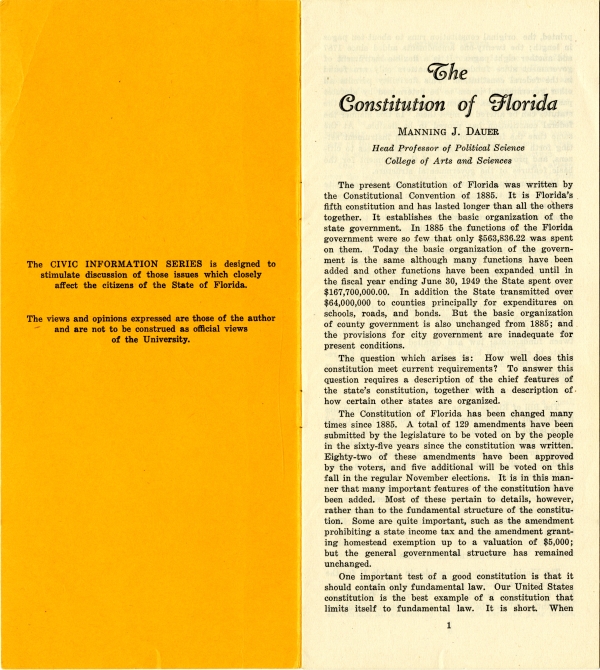


 Listen: The Latin Program
Listen: The Latin Program